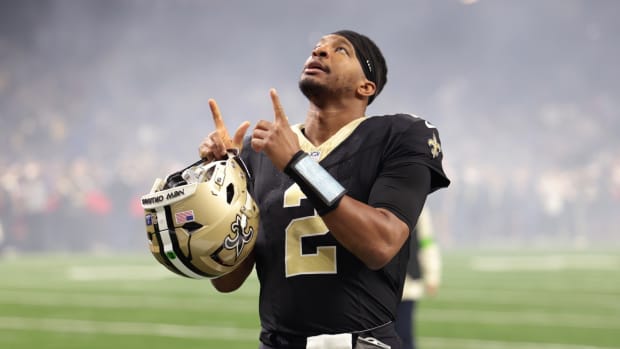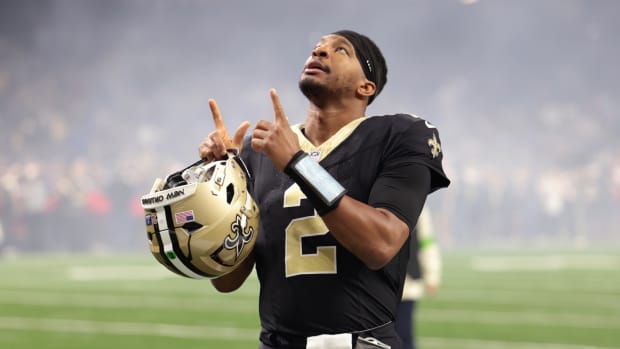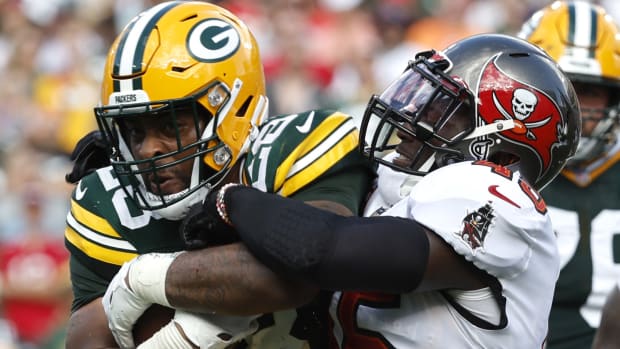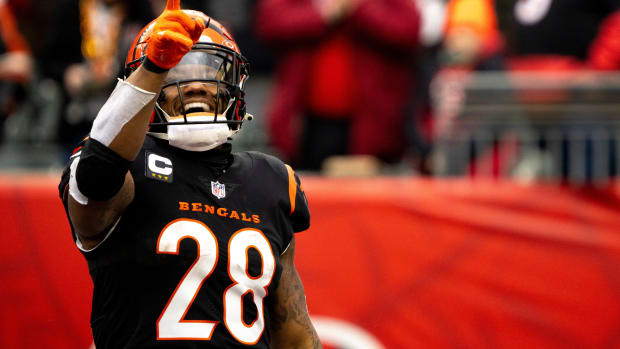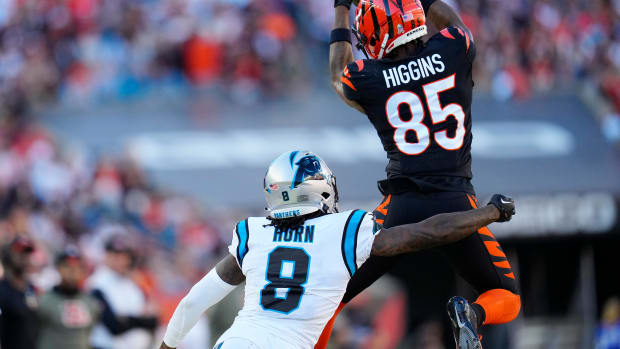
Week 7: Decisive Moments
The morning after most of Week 7 was played, the big topics were serious injuries around the league that will have deep impacts (Reggie Wayne, Jay Cutler, Sam Bradford, Lance Briggs, Jermichael Finley, Brian Cushing, Leon Hall, Doug Martin), and a controversial new rule enforced at a curious time to help the New York Jets beat the New England Patriots. Since that play has been dissected ad nauseam (Zapruder film and grassy knoll theories are making the rounds about a rule that was correctly called), we’ll move onto to some other key plays on Sunday, including one from that Jets-Patriots game.
In this week’s Decisive Moments, we’ll discuss: how pass-rush lane indiscipline by two Patriots rookies led to the Jets‘ taking the lead and building confidence; how Case Keenum played very well against the Kansas City Chiefs for most of his first start, but his inexperience cost the Houston Texans a key first down late; how Robert Mathis’s strip-safety of Peyton Manning changed the Indianapolis Colts-Denver Broncos game; and how great blocking by the Buffalo Bills and a poor run fit by the Miami Dolphins sealed a Buffalo win.
That’s where we’ll start.
* * *
Buffalo at Miami
Score: Dolphins 21, Bills 20
Time: 2:37 left in the fourth quarter
Situation: 3rd-and-4 at the Miami 28
Result: 10-yard run by Fred Jackson for a first down
Bills personnel: “21” or regular personnel (two backs, one tight end, two receivers)
Dolphins personnel: Base 3-4
What happened: Absolutely, the Mario Williams strip/sack given up by Dolphins right tackle Tyson Clabo was very big and put the Bills in position to take the lead. But if the Dolphins could come up with a stop on third down and force a field goal here, they’d be trailing by two points with more than two minutes remaining—plenty of time to win the game with their own field goal.
This play was one of those situations where both sides know it’s highly probable the offense is going to run the ball, at least to get the Dolphins to spend their final timeout. And in this instance, this was a game-planned play the Bills had been holding in their back pocket to use in this game.
“It was a play we had run all week and thought that it would be a great play for us to call in that situation,” running back Fred Jackson told The MMQB on Monday. “That was a good time for us to do it. In that situation you’re not expecting the other team to run outside [to the short side of the field], where there’s an opportunity to get knocked out of bounds.”
For the offense, it’s about executing blocks. On defense, it’s about making sure to fit the run properly. “Run fit” is one of those football terms you often hear but might not understand. It’s very simple: Each player is assigned a gap to defend on a running play. If each player does his job, there should be no room for the running back to run. Vacate or get pushed out of your assigned lane, and a hole will open.
This play had both great blocking and a poor run fit.
For the Bills, it was center Eric Wood (70), right guard Kraig Urbik (60), right tackle Erik Pears (79), tight end Lee Smith (85), fullback Frank Summers (38) and Jackson.
There were two key zone blocks on the play. Wood had to reach block and then turn Dolphins nosetackle Paul Soliai (96), who was shaded toward where the ball would be run. No matter—it’s still Woods’ job to get his right arm on Soliai’s left shoulder and then turn him away from the gap. Urbik had to double end Derrick Shelby (79) with Pears (79), and then get to the second level and get linebacker Jason Trusnik (93) out of his run fit (between Soliai and Shelby). Trusnick, who was starting for injured Dannell Ellerbe, did most of the work for Urbik by slightly overpursuing the play. Urbik then shoved him out of the lane.
“Those are the two blocks that we needed the most,” Jackson said. “When the guard gets to the second level like that and roots out the linebacker, that gives me an opportunity to get my shoulders square and run downhill. Urbik did a great job at that.”
Jackson’s job was to properly read his blocks, and then make the one unaccounted for player—weakside linebacker Philip Wheeler (52)—miss. Wheeler hit Jackson short of the first-down marker but failed to wrap him up. Jackson plowed through, picked up 10 yards and enabled the Bills to wind the clock down before kicking the field goal. The Dolphins, with 23 seconds left and no timeouts, couldn’t get anything done on their final possession (despite a decent runback on the Buffalo kickoff). A stop on that third down could have changed everything.
“If you don’t wrap up, I pride myself on making you miss,” Jackson said. “If he’s just going to come downhill and not wrap up, that gives me the opportunity that I need to get the extra yardage. He met me, I had to break the tackle, and I just kept my legs turning. Getting that first down right there is huge for us, allows us to run a lot of time off the clock.”
* * *
New England at New York Jets
Score: Patriots 21, Jets 17
Time: 5:51 in the third quarter
Situation: 3rd-and-15 at the New England 24
Result: 14-yard run by Jets quarterback Geno Smith
Jets personnel: “11” or “posse” (one back, one tight end, three receivers)
Patriots personnel: Dime (six defensive backs)
What happened: The Patriots had control of the game and looked ready to continue that after a false-start penalty backed the Jets into 3rd-and-long. New England decided to play a solid coverage—“two man,” or two deep safeties with man coverage underneath—to force a field goal. If there’s one drawback in playing man coverage, even under two deep safeties, it’s that the cover players will have their backs to the quarterback and won’t be able to react quickly if he breaks the pocket and runs. That’s what happened here.
Even still, the Patriots are normally so disciplined up front against an athletic passer like Smith that they can contain the run by staying in their pass-rush lanes to prevent a big hole from opening up. On this play, because of depth issues, the Patriots wound up with two rookies—tackle Chris Jones (94, playing for the injured Vince Wilfork) and end Michael Buchanan (99)—playing on the same side. In this situation players are normally coached not to rush past the quarterback on the outside, and not to get out of your lane on the inside. Here, Jones got shoved inside by left guard Brian Winters (67), and Buchanan was ridden outside by left tackle D’Brickashaw Ferguson (60). That left a huge hole for Smith to run through. Then in the secondary, cornerback Marquice Cole (23) and rookie safety Duron Harmon (30) were slow to react to prevent Smith from gaining the first down. Smith ended up breaking a Cole tackle and surging forward for a first down. Two plays later he scored a touchdown on a nearly identical breakdown when three second-level defenders failed to make the tackle.
“It was definitely a breakdown in our rush lanes with the pass rush,” Patriots coach Bill Belichick said Monday. “We could have possibly reacted to it a little bit quicker in the secondary. That might have saved a couple yards which would have made a difference, but that’s the responsibility of the pass rush—to keep him from doing that. Everybody else was locked up in coverage. Once he crosses the line of scrimmage, some players are available or freed up at that point to leave their coverage, and we could have maybe reacted to that a little quicker. We just didn’t do a good enough job on the pass rush of keeping him in there, which again is a combination of coaching and playing.”
* * *
Houston at Kansas City
Score: Chiefs 17, Texans 16
Time: 4:38 left in the fourth quarter
Situation: 3rd-and-4 at the Houston 28
Result: QB Case Keenum sacked by Tamba Hali for a 10-yard loss
Texans personnel: “01” or “Kings” (no backs, one tight end, four receivers)
Chiefs personnel: Dime (six defensive backs)
What happened: Texans second-year quarterback Case Keenum did a lot of things right in his first career start, especially at formidable Arrowhead Stadium against the league’s top pass defense. But there were moments when his inexperience showed, and this key third down was an example of that.
The Chiefs did a nice job of not giving a clean picture to Keenum of how they were going to bring pressure, with six players near the line of scrimmage. It looked as if the Texans thought they had hat-on-a-hat (one blocker for every rusher) with inside linebacker Akeem Jordan (55) and safety Eric Berry (29) accounted for, and outside linebacker Tamba Hali (91) apparently in coverage against slot receiver Lestar Jean . But the Chiefs ran a first zone exchange, with Jordan faking a rush then spying Keenum, Berry dropping into tight end Garrett Graham (88), and Hali rushing the quarterback.
A quarterback knows which defenders his blockers have accounted for, and any free rushers are his responsibility. It appeared that Keenum didn’t see Hali and also missed two open receivers. Jean was wide open on a quick slant as safety Quintin Demps (35) was slow getting into coverage, and Andre Johnson was also open once he made a great fake on cornerback Sean Smith (27) to get him turned completely around.
In that situation it’s up to Keenum to recognize a free blitzer and find the player(s) left open. He had an opportunity there but missed it—something he likely won’t do with more playing time.
“Yeah, they were doing a good job, and I got confused,” Keenum said. “My guys were working to get open, and I just need to get the ball out.
“I didn’t make the throws when I needed to. That’s how it goes. I had confidence in myself, but I know I can do better. I thought the coaches did a great job of calling the plays and putting me in great positions at times. I just didn’t get it done when it counted.”
* * *
Denver at Indianapolis
Score: Broncos 14, Colts 10
Time: 9:01 left in second quarter
Situation: 3rd-and-7 at the Denver 9
Result: Strip/sack of Peyton Manning by end Robert Mathis for a safety
Colts personnel: Nickel (five defensive backs).
Broncos personnel: “11” or “posse” (one back, one tight end, three receivers)
What happened: The Colts were playing the Broncos very tough to this point, but to me, for a couple of reasons, this is the play that changed the game. The safety and ensuing touchdown drive represented a nine-point swing and gave the Colts a lead they would never relinquish. It also gave the Colts a boost of confidence against unbeaten Denver. And the hit by Mathis seemed to have an effect on Manning. After the safety, Manning didn’t seem to have the same zip on the ball he had shown this season. Maybe the play physically affected Manning, or maybe it was just psychological. But even though the passes before the safety were a small sample size, Manning’s numbers were different before and after.
His passes were less crisp and sometimes underthrown. At times, the Broncos still executed. On one fourth-quarter drive Eric Decker caught a 49-yard pass that should have been intercepted, an incomplete pass to Demaryius Thomas was underthrown, and so was the touchdown to Thomas later in the drive.
“I throw a lot of wobbly passes,” Manning said after the game. “I throw a lot of wobbly touchdowns, too.”
As to the play itself, there were two key components. Linebackers Erik Walden (93) and Jerrell Freeman (50) did a great job of hitting tight end Julius Thomas (80) off the line, and then Freeman continued with Thomas down the field and likely took away Manning’s preferred target. That caused Manning to go through his progressions and gave Mathis (98) the time needed to beat left tackle Chris Clark around the end and hit Manning’s arm to force the fumble.
















































